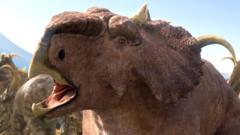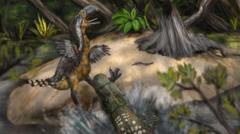Hidden beneath Alberta's verdant landscape lies a staggering mass grave, known as Pipestone Creek—also dubbed the "River of Death." This remarkable site, holding thousands of dinosaur fossils, serves as a portal to a catastrophic event that occurred 72 million years ago. A group of palaeontologists, led by Professor Emily Bamforth, is on a mission to unravel the mystery of how this colossal herd of Pachyrhinosaurus met its demise.
To uncover the secrets hidden beneath the layers of soil and stone, the team employs both brute and meticulous force, using sledgehammers to break through the rock. As they carefully excavate, fossilized bones begin to reveal themselves—each fragment adding a piece to an ancient puzzle. "That big blob of bone right there is, we think, part of a hip," explains Prof Bamforth, who is also keeping an eye on her dog Aster, tasked with alerting the team of any nearby wildlife.
Pipestone Creek has produced a wealth of fossilized remains, showcasing just how densely packed this graveyard is. "It is, we believe, one of the largest bone beds in North America," says the professor, as she highlights that up to 300 bones can be found in just one square meter. The excavation site, roughly the size of a tennis court, is only a fraction of what lies beneath—a sprawling bed of bones extending for a kilometer into the hillside.
The implications of these findings are significant. The Pachyrhinosaurus, a gentle giant of the Late Cretaceous period known for its three distinctive facial horns, provides a snapshot of what was once a thriving ecosystem. As the team studies the implications of animal migration and seasonal patterns, they’ve come to believe the dinosaurs were likely part of a large herd making a treacherous migration from warmer climates when disaster struck.
Two hours away from the main dig is the Deadfall Hills, where another group of palaeontologists are unearthing massive dinosaur bones washed ashore by turbulent waters—further contextualizing the region's prehistoric landscape. Among these discoveries are remains of Edmontosaurus, another herbivorous dinosaur that thrived alongside the Pachyrhinosaurus.
The task at hand is not just to catalogue fossils, but to understand the circumstances that led to their entombment. Researchers speculate that a sudden flash flood caused by storms uprooted trees and directed a torrent of water towards the migrating herd. "These animals wouldn’t have stood a chance," Prof Bamforth explains, noting that the sheer size and numbers of the dinosaurs would have hindered swift escape.
With research efforts yielding new insights each year, Prof Bamforth and her colleagues remain dedicated to uncovering yet more mysteries hidden within this prehistoric grave. "Every time we come here, it's 100% guaranteed we'll find bones," she remarks, demonstrating a profound commitment to dissecting the past one fossil at a time. As the excavation continues, the team is aware they are only beginning to scratch the surface of a long-forgotten story, one that promises to reveal many more secrets about life on Earth during the age of dinosaurs.



















